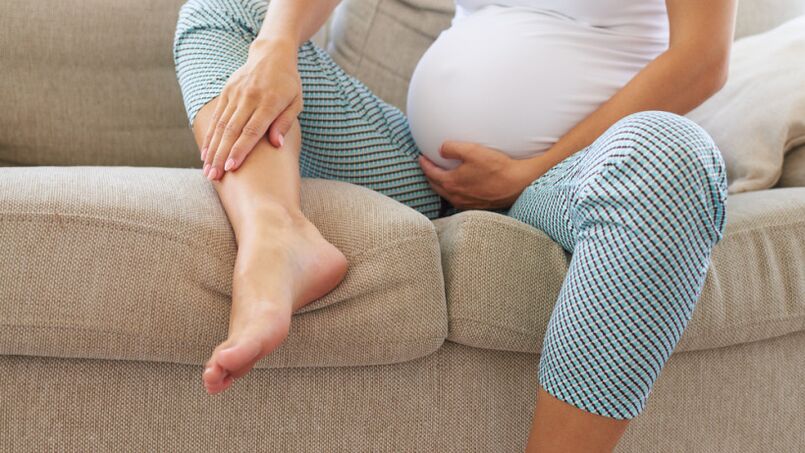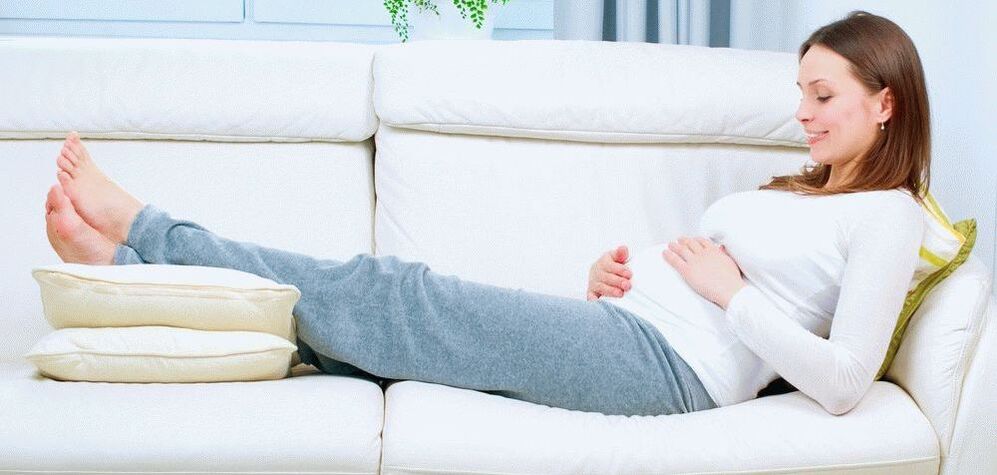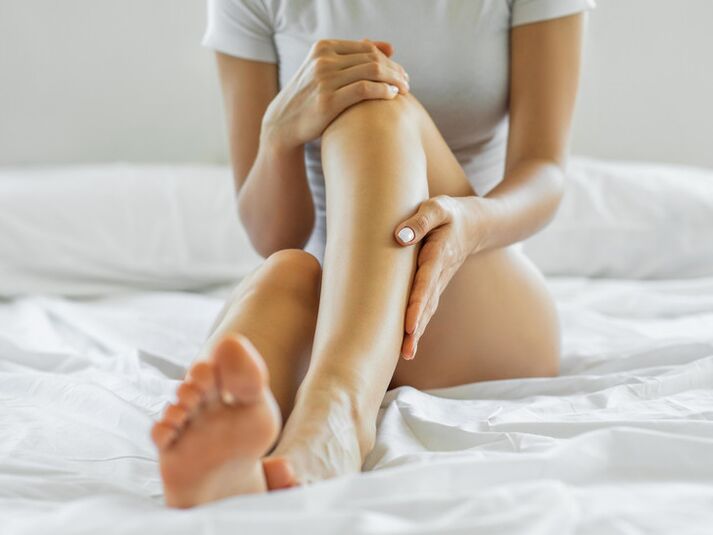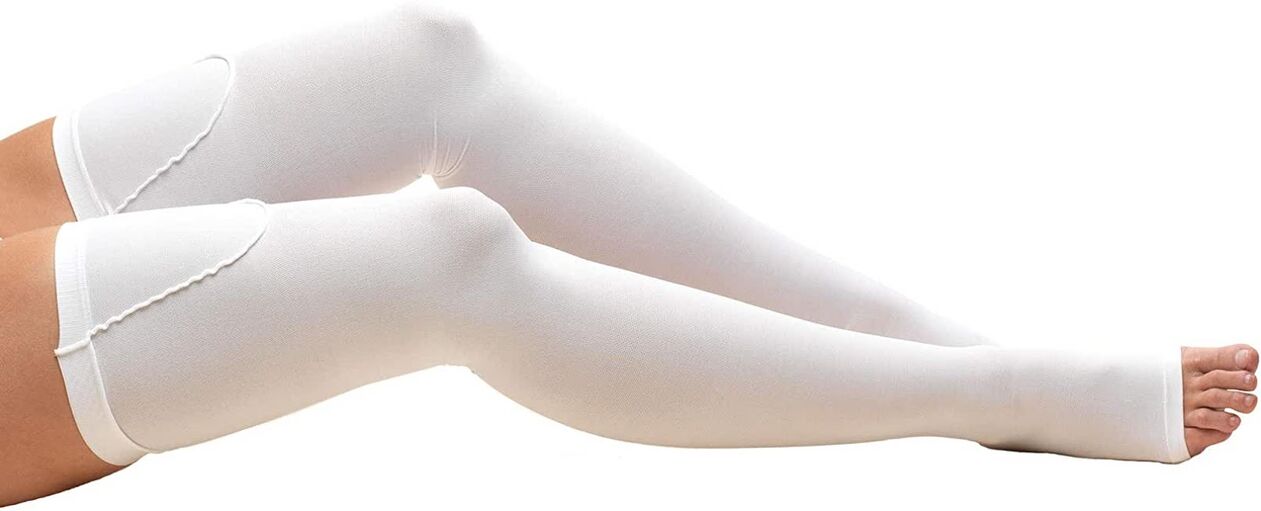
During pregnancy, a woman's body undergoes dramatic changes. The hormonal background changes completely, adapting to gestation and childbirth. As a result, the tone of the venous walls decreases, their permeability increases and microcirculation deteriorates. Varicose veins during pregnancy often spread to the lower extremities. Treatment of varicose veins during pregnancy should be timely and correct so as not to harm the baby.
Causes
Varicose veins are quite common during pregnancy. The more time a woman spends in one position, the greater the likelihood of such a pathology occurring. Her body is also largely influenced by genetic predisposition. The pregnancy period, especially the second and third trimesters, is a key factor in the development of varicose veins in women.
This pathology is due to the fact that the blood vessels of the lower limbs and pelvis suffer from excessive and prolonged stress. For a long time, blood vessels perform their function to the fullest. The constantly growing uterus puts a lot of pressure on the venous walls. This creates an obstacle to the full microcirculation of blood in the lower extremities.
Also, another reason for varicose veins during pregnancy is a constant increase in body weight. On average, a woman gains about ten kilograms during the entire nine months. And this is an additional load for ships. As a result, the veins of the lower extremities swell and expand significantly, causing severe stretching along their entire length. If there is a genetic predisposition to varicose veins, it is important to take preventive measures in a timely manner. Traditional medicine, which suggests the use of unconventional methods: baths, compresses, is effective in preventing varicose veins during pregnancy.
Women who work while standing or sitting for a long time face varicose veins during pregnancy much more often. Women who abuse long walks in high-heeled shoes are also susceptible to this disease. It is recommended to avoid wearing such products every day and limit yourself to the option with a heel height of no more than three centimeters.
Development factors
Provocative factors for the development of varicose veins of the legs during pregnancy are:
- Physical inactivity or leading a sedentary lifestyle.During gestation, especially in the last trimester, physical activity is inevitably limited. Sometimes the key to preserving the fetus is complete restriction of movement; the woman is forced to remain in bed most of the time. As a result, the veins of the lower extremities suffer, the tone of the blood walls decreases, and the access of blood and oxygen to the legs worsens. The result is the development of varicose veins.
- Increased load on the venous networks.During pregnancy, a woman constantly gains weight. Blood pressure increases and compression on the veins occurs. The expansion of the walls becomes persistent, and this is fraught with irreversible pathological processes.
- Dramatic changes in hormone levels.During gestation there is a rapid increase in progesterone levels. This hormone is responsible for the normal course of pregnancy and the preservation of the fetus. But it negatively affects the vascular system, causes the blood walls to stretch and begin to overflow with blood.
This disease can cause disorders in the hematopoietic system. As blood clotting increases, its circulation slows down. Stagnation occurs in the veins, the walls begin to expand under blood pressure. Other causes of the disease include:

- rapid weight gain – this happens if a woman does not eat properly;
- capillary networks and varicose veins present before the conception of the child;
- repeated pregnancies;
- waxing;
- carry heavy objects;
- prolonged exposure to direct sun.
Gynecologists and phlebologists never tire of talking about the possible influence of varicose veins on pregnancy. Because with reduced blood circulation and poor oxygen access to internal organs, not only the woman suffers, but also the child.
Symptoms
The first symptom of the development of such a pathology is a visual change. In the initial stages, networks and stars are visible on the surface of the epidermis. The veins become clearly visible. Their color becomes bluish, yellowish or greenish. If mild varicose disease develops, the pathology does not develop beyond the vascular networks.
But if the disease reaches a severe stage, the epidermis changes: pain in varicose veins, thickening and redness appear during pregnancy. In this case we can talk about the initial form of thrombophlebitis, which develops during gestation. Supplemented by the following clinical picture:
- severe swelling of the lower extremities;
- constant itching and burning in the affected areas;
- increased dryness of the epidermis;
- pain, seizures, especially at night;
- heaviness after physical activity, prolonged walking or even after minor walks;
- Ulcerations appear on the epidermis, which are difficult to eliminate.
The pain in your legs decreases if you lift them. Some women experience only external defects in the form of varicose veins, while others suffer from unpleasant symptoms, the intensity of which gradually worsens. If treatment is not carried out, various complications occur in the form of blood clots, phlebitis and trophic ulcers.
Signs
During the entire period of gestation, you need to monitor your health, monitor any changes and consult a doctor in a timely manner. Symptoms of varicose veins during pregnancy:
- your legs, ankles, and feet become swollen, swollen, and painful;
- attacks of spasms and cramps appear in the hips and legs, especially at night;
- heaviness in the lower limbs, especially in the afternoon;
- itching, burning, increased skin dryness;
- veins clearly visible above the surface of the skin;
- ulcerations on the epidermis, which are difficult to treat and do not heal for a long time;
- painful sensations, the intensity of which decreases if you raise your legs.
Varicose veins can spread not only to the lower extremities. There are other organs that suffer from high stress during pregnancy. Varicose veins of the external genitalia and vagina often develop. Convex veins are visually visible on the perineum and partially affect the buttocks area. The clinical picture of this disease looks like this:
- discomfort and pain of a pulling and aching nature appear in the lower abdomen;
- an annoying pain is felt during defecation;
- you feel a burning sensation when emptying the bladder;
- after emptying the bladder you feel itching and tingling;
- During intimacy, unpleasant sensations arise.
It is impossible to make a diagnosis based on external examination alone. In addition, it is necessary to undergo diagnostic measures.
Varicose veins by quarter
First quarter

In the first trimester of pregnancy, varicose veins often appear in a latent form. External signs of varicose veins in the early stages of pregnancy are limited to barely noticeable varicose veins, tired legs and discomfort after long walks. At this stage, you should not ignore such symptoms, it is better to contact a phlebologist in advance to prevent further progression of the pathological process. Properly selected venotonics, baths and lotions will help stop the development of the disease.
Second quarter
Varicose veins during pregnancy in the 2nd trimester are more pronounced. The constant pressure of the growing uterus and the heavy load on the legs negatively affects blood circulation and impairs access to oxygen.
Third quarter

In the 3rd trimester of pregnancy, varicose veins manifest themselves intensely in the absence of preventive measures in the previous stages. Severe swelling of the extremities, itching and tingling of the skin and attacks of nocturnal cramps appear. Properly selected therapy will help to cope with such manifestations.
Diagnostics
If superficial veins are affected, the doctor may suspect the development of varicose veins after the first examination. During the consultation, the phlebologist collects anamnestic data and takes into account the patient's complaints. To make a correct diagnosis, the following types of examination are prescribed:
- general urinalysis;
- clinical blood test;
- study of the biochemical parameters of the blood;
- ultrasound;
- double-sided scanning;
- If necessary, MRI may be prescribed.
Treatment

During the gestation period, conservative therapeutic methods are used to treat varicose veins:
- Wear medical hosiery with compression properties.It is recommended to wear shapewear, stockings, tights and knee-highs. Thanks to this knitwear, blood vessels are maintained in proper condition, veins do not dilate and blood flow improves. It is indicated to wear such products during the day, and if there are problems with the veins, the stockings are also not removed at night.
- Use suitable shoes.Products with stilettos, platforms and high heels are prohibited. When regularly wearing such shoes, a high load occurs on the muscles of the lower extremities, natural blood circulation deteriorates, and rapid fatigue appears. It is advisable to choose comfortable and stable shoes with low heels.
- Measured physical activity.During the gestation of varicose veins, congestion occurs, so it is necessary to get rid of it. To do this, it is recommended to swim, walk more and perform special therapeutic exercises.
- Maintain a proper diet.To make the walls of blood vessels stronger, it is recommended to include in the menu foods rich in ascorbic acid, tocopherol, nicotinic acid and B vitamins. Products containing potassium, magnesium and manganese will also be useful. The diet should contain foods rich in fiber. They are a good preventative against constipation.
If the doctor deems it appropriate, local drugs can be prescribed: gels, ointments, creams, which in their action are venotonics and phlebotonics. During pregnancy, the choice of drugs must be correct so as not to cause complications. Ointments containing glycosaminoglycans are effective and safe. They prevent blood clotting and the formation of blood clots. Venotonics can be used starting from the 2nd trimester. They have anti-edematous, anti-inflammatory and vascular strengthening properties.
In advanced cases, the disease is treated surgically. Such methods are used only when there is a threat of thrombophlebitis. A modern treatment method is sclerotherapy.

What else do phlebologists recommend to alleviate the condition:
- often lifts legs;
- after a hard day at work, soak your feet in warm water with dissolved sea salt for half an hour;
- do not cross your legs, do not throw them on top of each other, so as not to interrupt blood circulation;
- frequently change body position, warm up periodically;
- sleep on your left side;
- control the consumption of salty foods;
- control body weight.
Prevention
Preventive measures will reduce the load on the legs and improve blood flow. It is recommended to take a comfortable position for the body more often and raise the legs to an elevated position as often as possible. This ensures the outflow of blood and lymphatic fluid and prevents stagnation.
During the day, periodically perform simple gymnastic exercises: stretch your toes and heels, make circular movements with your toes. To ensure proper blood microcirculation, it is important to eat well, swim and walk more.
It is important to avoid wearing tight and uncomfortable products, wedge shoes and heels. Tight pants and tight socks are prohibited. It is advisable to arrange contrasting foot baths. Refuse to visit the bathhouse and sauna and do not take a hot bath.
Following simple rules will help avoid the appearance of pathological processes in the blood vessels. If the first signs of varicose veins appear, you need to visit a phlebologist as soon as possible. After the exam the doctor will decide how to proceed. It is forbidden to use drugs alone.



















